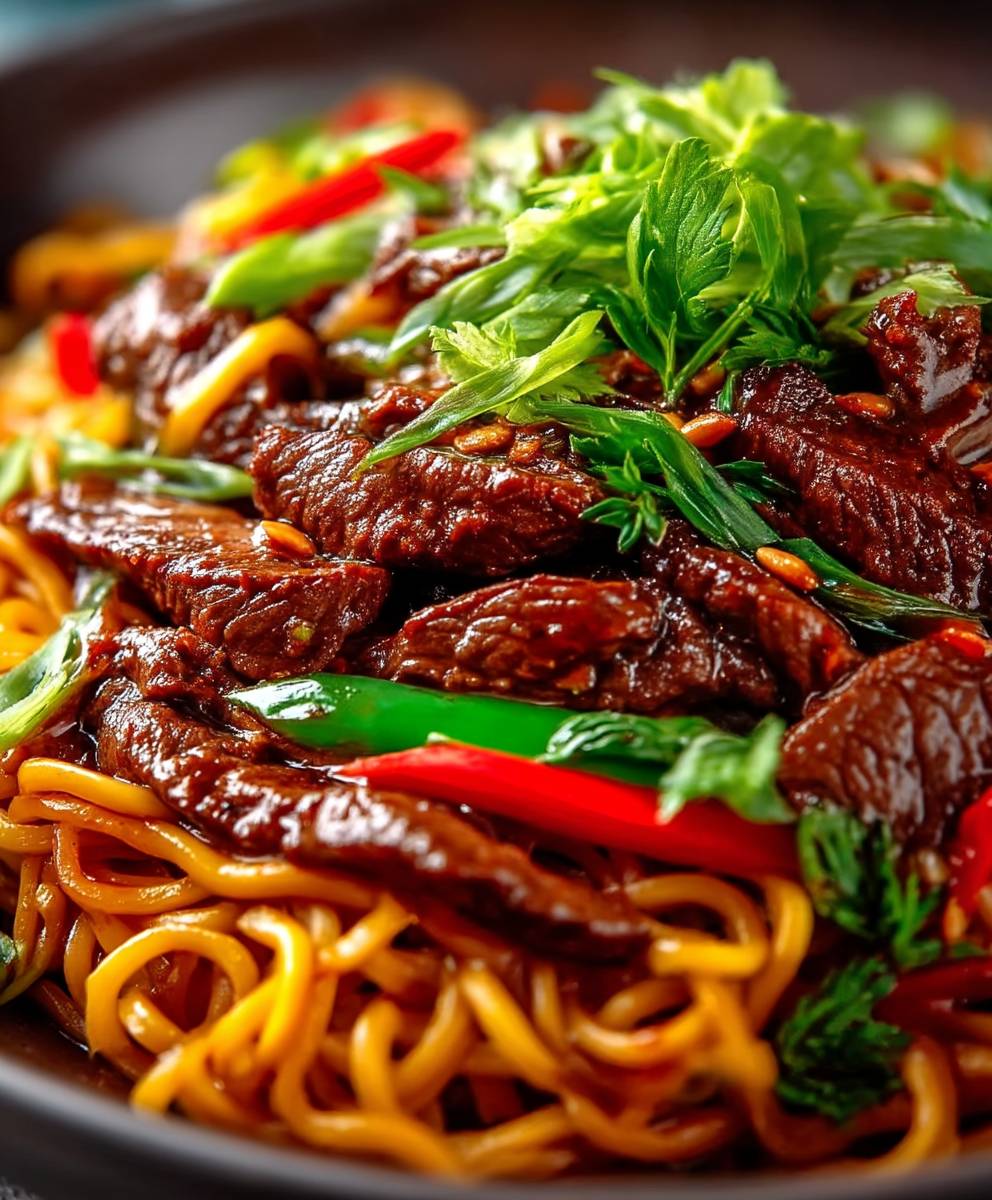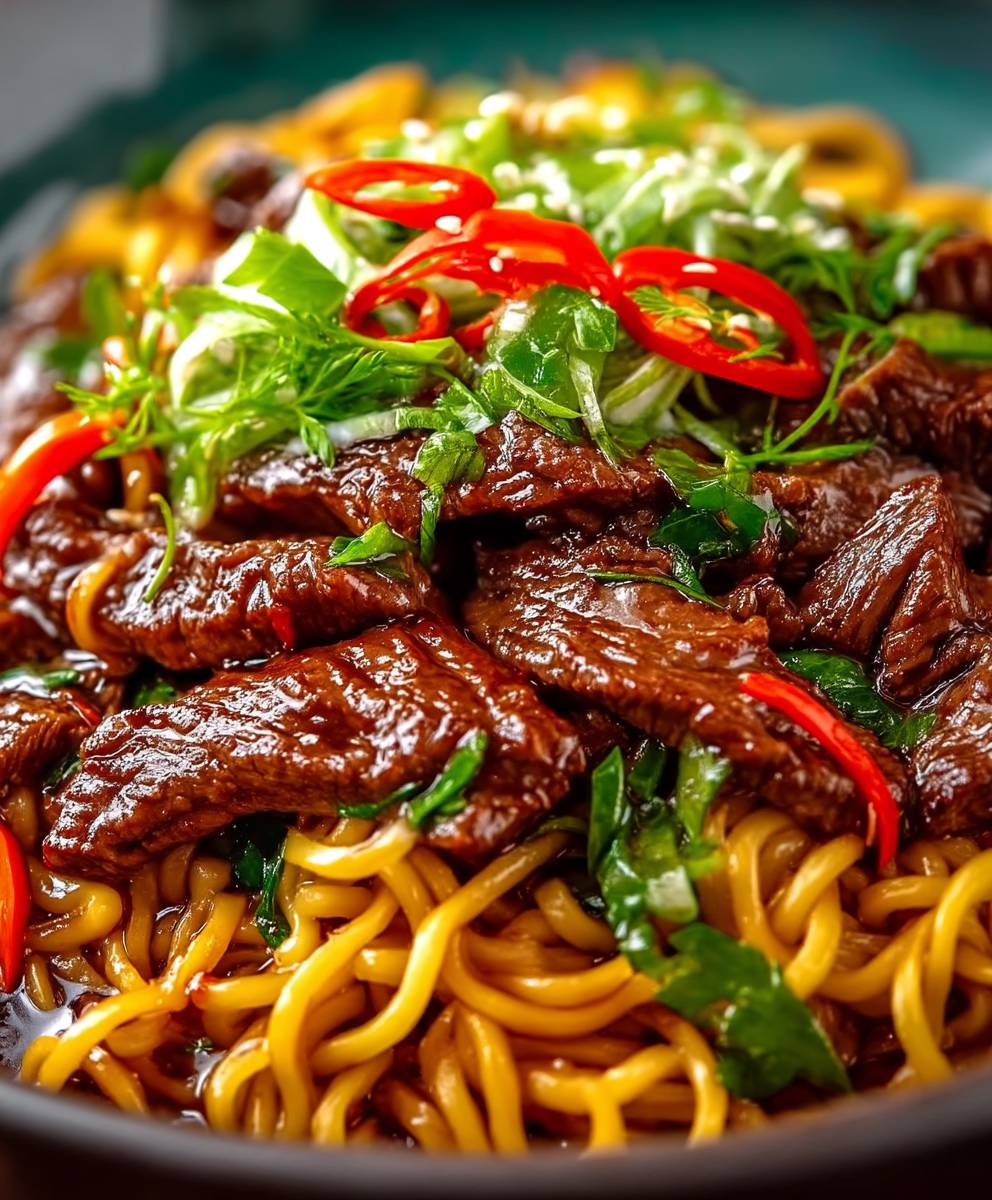Sticky Beef Noodles: Prepare to embark on a culinary adventure that will tantalize your taste buds and leave you craving more! Imagine sinking your teeth into perfectly cooked noodles, coated in a luscious, savory sauce, and studded with tender, melt-in-your-mouth beef. This isn’t just a meal; it’s an experience.
The beauty of Sticky Beef Noodles lies not only in its incredible flavor profile but also in its simplicity. While variations of this dish can be found across various Asian cuisines, its core appeal remains consistent: a harmonious blend of sweet, savory, and umami notes that dance on your palate. Think of it as a comforting hug in a bowl, perfect for a cozy night in or a quick and satisfying weeknight dinner.
What makes this dish so universally loved? For starters, the texture is divine. The slightly chewy noodles provide a delightful contrast to the tender beef, all enveloped in a sticky, glossy sauce that clings to every strand. The combination of flavors is equally irresistible. The sweetness balances the savory notes, while a hint of spice adds a delightful kick. And let’s not forget the convenience! This recipe is surprisingly easy to make, requiring minimal ingredients and effort. So, are you ready to create your own unforgettable bowl of Sticky Beef Noodles? Let’s get cooking!
Ingredients:
- For the Beef:
- 1.5 lbs Beef Sirloin, thinly sliced against the grain
- 2 tbsp Cornstarch
- 1 tbsp Vegetable Oil
- 1 tbsp Soy Sauce
- 1 tsp Ground Ginger
- 1/2 tsp Garlic Powder
- 1/4 tsp Black Pepper
- For the Noodles:
- 1 lb Fresh Egg Noodles (or dried, cooked according to package directions)
- 1 tbsp Sesame Oil
- For the Sticky Sauce:
- 1/2 cup Soy Sauce
- 1/4 cup Brown Sugar, packed
- 1/4 cup Rice Vinegar
- 2 tbsp Honey
- 2 tbsp Oyster Sauce
- 1 tbsp Cornstarch
- 1 cup Beef Broth
- 2 cloves Garlic, minced
- 1 inch Ginger, grated
- 1/2 tsp Red Pepper Flakes (optional, for heat)
- For the Garnish:
- 2 Green Onions, thinly sliced
- 1 tbsp Sesame Seeds
Preparing the Beef:
- In a large bowl, combine the thinly sliced beef sirloin with cornstarch, vegetable oil, soy sauce, ground ginger, garlic powder, and black pepper. Make sure the beef is evenly coated with the mixture. This helps to tenderize the beef and create a nice crust when it’s cooked. I like to use my hands to really massage the marinade into the meat, ensuring every piece is covered.
- Let the beef marinate for at least 15 minutes at room temperature, or up to an hour in the refrigerator. The longer it marinates, the more flavorful and tender it will become. If you’re short on time, 15 minutes is fine, but I highly recommend letting it sit for longer if you can.
Cooking the Beef:
- Heat a large skillet or wok over high heat. It’s important to get the pan really hot before adding the beef, as this will help it to sear properly and prevent it from steaming. A wok is ideal for this recipe because of its shape, which allows for even heat distribution and easy tossing.
- Add the marinated beef to the hot skillet in a single layer. Avoid overcrowding the pan, as this will lower the temperature and cause the beef to steam instead of sear. If necessary, cook the beef in batches. I usually do this in two batches to ensure that each piece gets a nice, crispy sear.
- Cook the beef for 2-3 minutes per side, or until it is browned and cooked through. Be careful not to overcook the beef, as it will become tough. You want it to be tender and juicy. The internal temperature should reach 145°F (63°C) for medium-rare, but since the beef is thinly sliced, it will likely be closer to medium.
- Remove the cooked beef from the skillet and set aside. Keep it warm while you prepare the sauce. I usually cover it with foil to prevent it from drying out.
Preparing the Sticky Sauce:
- In a medium bowl, whisk together the soy sauce, brown sugar, rice vinegar, honey, oyster sauce, and cornstarch. Make sure the cornstarch is fully dissolved to prevent lumps in the sauce. This mixture will create the perfect balance of sweet, savory, and tangy flavors that make this dish so irresistible.
- In the same skillet or wok that you used to cook the beef, add the beef broth, minced garlic, and grated ginger. Scrape up any browned bits from the bottom of the pan, as these will add extra flavor to the sauce. Those browned bits are called fond, and they’re packed with umami goodness!
- Bring the mixture to a simmer over medium heat. Let it simmer for a minute or two to allow the garlic and ginger to infuse the broth with their flavors. The aroma at this point is simply divine!
- Pour the soy sauce mixture into the skillet and stir constantly. Continue to cook the sauce until it thickens, about 3-5 minutes. The cornstarch will act as a thickening agent, creating a glossy and sticky sauce that clings to the beef and noodles.
- If you like a little heat, add the red pepper flakes to the sauce. Adjust the amount to your liking. I personally love a little kick, but you can easily omit them if you prefer a milder flavor.
Assembling the Noodles:
- While the sauce is thickening, prepare the noodles according to package directions. If using fresh egg noodles, they usually only take a few minutes to cook. If using dried noodles, be sure to cook them until they are al dente, or slightly firm to the bite.
- Drain the cooked noodles and toss them with sesame oil. This will prevent them from sticking together and add a nutty flavor. I love the aroma of sesame oil it really elevates the dish.
- Add the cooked beef to the skillet with the sticky sauce and toss to coat. Make sure every piece of beef is evenly coated with the sauce. This is where the magic happens!
- Add the noodles to the skillet with the beef and sauce and toss everything together until the noodles are evenly coated. Use tongs to gently toss the noodles and beef, ensuring that they don’t break apart.
Serving:
- Serve the sticky beef noodles immediately. Garnish with sliced green onions and sesame seeds. The green onions add a fresh, vibrant flavor, while the sesame seeds provide a nutty crunch.
- Enjoy! This dish is best served hot and fresh. It’s perfect for a weeknight dinner or a special occasion. I guarantee it will be a crowd-pleaser!
Tips and Variations:
- Vegetables: Feel free to add your favorite vegetables to this dish. Broccoli, bell peppers, carrots, and snap peas all work well. Add them to the skillet along with the garlic and ginger and cook until tender-crisp.
- Protein: If you’re not a fan of beef, you can substitute chicken, pork, or tofu. Just adjust the cooking time accordingly.
- Spice Level: Adjust the amount of red pepper flakes to your liking. You can also add a dash of sriracha or chili oil for extra heat.
- Sweetness: If you prefer a sweeter sauce, add a little more honey or brown sugar.
- Noodle Type: While egg noodles are traditional, you can use other types of noodles, such as udon, ramen, or even spaghetti.
- Make Ahead: You can prepare the beef and sauce ahead of time and store them separately in the refrigerator. When you’re ready to eat, simply reheat the beef and sauce and toss with the cooked noodles.
Storage Instructions:
Store leftover sticky beef noodles in an airtight container in the refrigerator for up to 3 days. Reheat in the microwave or on the stovetop until heated through.
Nutritional Information (Approximate):
Please note that the nutritional information is an estimate and may vary depending on the specific ingredients used.
- Calories: 600-800 per serving
- Protein: 30-40g
- Fat: 20-30g
- Carbohydrates: 60-80g
Why This Recipe Works:
This recipe is a winner because it combines tender, flavorful beef with perfectly cooked noodles and a sticky, irresistible sauce. The balance of sweet, savory, and tangy flavors is simply divine. The use of cornstarch in both the beef marinade and the sauce ensures that the beef is tender and the sauce is thick and glossy. The addition of garlic, ginger, and red pepper flakes adds depth and complexity to the flavor profile. And the garnish of green onions and sesame seeds provides a fresh, vibrant finish.
Serving Suggestions:
This dish is delicious on its own, but it also pairs well with other Asian-inspired dishes, such as spring rolls, dumplings, or stir-fried vegetables. You can also serve it with a side of steamed rice or a simple salad.
Ingredient Substitutions:
- Beef Sirloin: You can substitute other cuts of beef, such as flank steak or skirt steak. Just be sure to slice it thinly against the grain.
- Egg Noodles: You can use other types of noodles, such as udon, ramen, or spaghetti.
- Soy Sauce: You can use tamari

Conclusion:
This isn’t just another noodle dish; it’s an experience. The rich, savory sauce clinging to perfectly cooked noodles, the tender beef practically melting in your mouth its a symphony of flavors and textures that will leave you craving more. I truly believe this Sticky Beef Noodles recipe is a must-try for anyone who appreciates a comforting, flavorful, and relatively quick weeknight meal. It’s the kind of dish that becomes a family favorite, requested again and again.
But the best part? It’s incredibly versatile! While I’ve outlined my go-to method, feel free to experiment and make it your own. Feeling adventurous? Add a pinch of red pepper flakes for a touch of heat. Want to sneak in some extra veggies? Sauté some sliced bell peppers, mushrooms, or broccoli along with the beef. For a lighter take, try using ground turkey or chicken instead of beef. You could even swap out the noodles for zucchini noodles or spaghetti squash for a low-carb option.
Serving Suggestions and Variations:
* Classic Comfort: Serve the Sticky Beef Noodles as is, garnished with a sprinkle of sesame seeds and some chopped green onions. A side of steamed bok choy or Chinese broccoli would complete the meal perfectly.
* Spicy Kick: Add a drizzle of sriracha or chili oil for an extra layer of heat.
* Veggie Boost: Stir in some stir-fried vegetables like snap peas, carrots, and bean sprouts.
* Peanut Power: Add a tablespoon of peanut butter to the sauce for a nutty and creamy twist.
* Crispy Noodles: For a textural contrast, serve the Sticky Beef Noodles over a bed of crispy fried noodles.
* Lunchbox Hero: These noodles are fantastic cold or at room temperature, making them ideal for lunchboxes.I’ve poured my heart into perfecting this recipe, and I’m confident that you’ll love it as much as I do. The beauty of cooking is in the sharing, so I urge you to give this Sticky Beef Noodles recipe a try. Don’t be intimidated by the ingredient list; it’s all about layering flavors, and the process is surprisingly simple. I promise, the end result is well worth the effort.
Once you’ve had a chance to whip up a batch of these delectable noodles, I’d absolutely love to hear about your experience! Did you make any modifications? What did you think of the flavor? What did your family think? Share your photos, tips, and feedback in the comments below. Your insights not only help me improve the recipe but also inspire other home cooks to embark on their own culinary adventures. Let’s create a community of noodle lovers, one delicious bowl at a time! So, get cooking, and let me know what you think! I can’t wait to hear from you!
Sticky Beef Noodles: The Ultimate Guide to Making Them at Home
Tender beef and egg noodles tossed in a sweet, savory, and sticky sauce, garnished with green onions and sesame seeds. A quick and easy weeknight meal!
Ingredients
- 1.5 lbs Beef Sirloin, thinly sliced against the grain
- 2 tbsp Cornstarch
- 1 tbsp Vegetable Oil
- 1 tbsp Soy Sauce
- 1 tsp Ground Ginger
- 1/2 tsp Garlic Powder
- 1/4 tsp Black Pepper
- 1 lb Fresh Egg Noodles (or dried, cooked according to package directions)
- 1 tbsp Sesame Oil
- 1/2 cup Soy Sauce
- 1/4 cup Brown Sugar, packed
- 1/4 cup Rice Vinegar
- 2 tbsp Honey
- 2 tbsp Oyster Sauce
- 1 tbsp Cornstarch
- 1 cup Beef Broth
- 2 cloves Garlic, minced
- 1 inch Ginger, grated
- 1/2 tsp Red Pepper Flakes (optional, for heat)
- 2 Green Onions, thinly sliced
- 1 tbsp Sesame Seeds
Instructions
- Preparing the Beef: In a large bowl, combine the thinly sliced beef sirloin with cornstarch, vegetable oil, soy sauce, ground ginger, garlic powder, and black pepper. Ensure the beef is evenly coated. Marinate for at least 15 minutes at room temperature, or up to an hour in the refrigerator.
- Cooking the Beef: Heat a large skillet or wok over high heat. Add the marinated beef in a single layer. Cook for 2-3 minutes per side, or until browned and cooked through. Remove from skillet and set aside, keeping warm.
- Preparing the Sticky Sauce: In a medium bowl, whisk together the soy sauce, brown sugar, rice vinegar, honey, oyster sauce, and cornstarch. In the same skillet used for the beef, add the beef broth, minced garlic, and grated ginger. Scrape up any browned bits. Bring to a simmer over medium heat.
- Pour the soy sauce mixture into the skillet and stir constantly. Cook until the sauce thickens, about 3-5 minutes. Add red pepper flakes, if desired.
- Assembling the Noodles: While the sauce is thickening, prepare the noodles according to package directions. Drain the cooked noodles and toss them with sesame oil.
- Add the cooked beef to the skillet with the sticky sauce and toss to coat. Add the noodles to the skillet with the beef and sauce and toss everything together until the noodles are evenly coated.
- Serving: Serve the sticky beef noodles immediately. Garnish with sliced green onions and sesame seeds.
Notes
- Vegetables: Add your favorite vegetables like broccoli, bell peppers, carrots, or snap peas. Add them to the skillet along with the garlic and ginger and cook until tender-crisp.
- Protein: Substitute chicken, pork, or tofu for beef. Adjust cooking time accordingly.
- Spice Level: Adjust the amount of red pepper flakes to your liking. Add sriracha or chili oil for extra heat.
- Sweetness: Add more honey or brown sugar for a sweeter sauce.
- Noodle Type: Use udon, ramen, or even spaghetti instead of egg noodles.
- Make Ahead: Prepare the beef and sauce ahead of time and store separately. Reheat and toss with cooked noodles when ready to eat.
- Storage Instructions: Store leftovers in an airtight container in the refrigerator for up to 3 days. Reheat in the microwave or on the stovetop.

